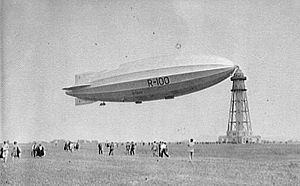R100
| HM Airship R100 | |
|---|---|
 |
|
| R100 at its mooring mast in St. Hubert, Quebec, Canada. | |
| Role | passenger airship |
| National origin | United Kingdom |
| Manufacturer | Vickers |
| First flight | 16 December 1929 |
| Number built | 1 |
His Majesty's Airship R100, known simply as R100, was a privately designed and built rigid British airship made as part of a two-ship competition to develop a commercial airship service for use on British Empire routes as part of the Imperial Airship Scheme. The other airship, the R101, was built by the British Air Ministry, but both airships were funded by the Government.
R100 was built by the Airship Guarantee Company, a specially-created subsidiary of the armaments firm, Vickers-Armstrongs, led by Commander Dennis Burney, with the design team headed by Barnes Wallis, later famous for his invention of the bouncing bomb. The design team also included Nevil Shute Norway as the senior stress engineer.
R100 first flew in December 1929. It made a series of trial flights and a successful return crossing of the Atlantic in July–August 1930, but following the crash of R101 in October 1930 the Imperial Airship Scheme was terminated and it was broken up for scrap.
R100 was built as part of a British government programme to develop airships to provide passenger and mail transport between Britain and the countries of the British Empire, including India, Australia and Canada. This had its origin in Dennistoun Burney's 1922 proposal for a civil airship development programme to be subsidised by the Government and carried out by a specially established subsidiary of Vickers. When the General Election of 1923 brought Ramsay MacDonald’s Labour administration to power, the new Air Minister, Lord Thomson formulated the Imperial Airship Scheme in its place. This called for the building of two experimental airships: one, R101, to be designed and constructed under the direction of the Air Ministry, and the other, R100, to be built by the Vickers subsidiary under a fixed price contract.
...
Wikipedia
